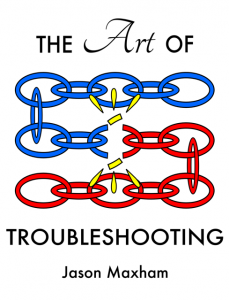
This is an unusual book in a way, because normally the technique for troubleshooting is explained for each individual problem – a toaster would be fixed with a different approach to fixing a car. But in Maxham’s book, he gives philosophy-based processes to fix anything you need to fix. He says,”all machine problems are human problems”, which means, of course, that solving the problems we face when something breaks is obviously down to the way we approach it. His “universal recipe” for troubleshooting is two-fold – Find the problem, and fix it. Which sounds glib. But when you think about it, most people panic instead of focusing into the machine’s anatomy, so it’s more practical than it sounds. By using quotes, diagrams and other troubleshooting colleagues’ sage advice on troubleshooting, Maxham has produced a fun book – not an easy task, given his subject matter.
There are some presentation issues – the book needs a proofread and images need an edit for e-readers. Having said that, this is a rare occasion I didn’t care much (so the editing gods strike me down). The book’s content is engrossing, and I’m probably a bit nerdy, but I’m no gearhead or computer geek, and this turned me on to wanting to be the sort of exotic egghead female who is sometimes seen in an engineering setting, or perhaps a computer lab. Given Maxham’s enthusiasm for his subject, I can imagine this book being practically inhaled by any young person looking to get into any kind of industry that uses troubleshooting strategies – or like me, a woman wanting to be more independent with a tool kit.
As Maxham points out, the new culture of throwing things out instead of fixing them has to stop unless we want to drown in landfill on this planet, so there is a definite environmental point to be made here, and also an economical one. Do we owe it to the future to mend things instead of stating that “it’s quicker and easier to buy a new one”?
Maxham writes an entertaining argument; of course, this book would not be complete without his relating a ridiculous MacGyver episode when a telescope is made into a harpoon launcher. I did laugh out loud a few times, and that’s no mean feat when I am basically learning some pretty dense and advanced processes. I love that he mixes NLP, Neuro Linguistic Programming in there, because he puts the flesh on the bones of semantics – turning nouns to verbs, i.e. objects into actions, seems very appropriate to those stuck fast in alarm unable to take the matter into their own hands.
The Art of Troubleshooting is a keeper – you never know when something might decide to break down, and then you’ll be lucky enough to have Jason Maxham’s jolly narrative to keep you chipper and positive about your fixing skills instead of immediately calling the shop for a new one. Maxham has kind of invented a new genre – this is not just a book about DIY, but a book about self-improvement and awareness. “”I can’t”,” he writes, is “clarified with, “What if I did?””
A fascinating and original book.
Links
Author Website
Amazon
Goodreads
Review Overview
Design
Content
Editing
Get an Editorial Review | Get Amazon Sales & Reviews | Get Edited | Get Beta Readers | Enter the SPR Book Awards | Other Marketing Services






















Leave A Comment